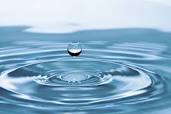Structure and Physical Properties of Water
Water (dihydrogen monoxide) covers over 70% of the earth’s surface. The hydrosphere (water from all sources on earth) contains about 1.36 billion cubic kilometres of water mostly in the form of liquid. Water is essential for life on earth and is found in all living organisms.
Water molecule contains two atoms of hydrogen bound covalently to one atom of oxygen. The two hydrogen atoms are attached to one side of the oxygen molecule giving it unique electrochemical properties. The side
containing hydrogen atoms is positively charged while the side dominated by oxygen atom is negatively charged .
There are strong forces of attraction between different molecules of water. The polarity of the water molecule makes water a powerful solvent and also gives it strong surface tension.
Water exists in three states – solid (ice), liquid (liquid water) and gas (steam or water vapour). It can change from one state to another. When water changes its state, molecules rearrange themselves differently.
The molecular arrangement of ice leads to increase in volume but a decrease in
density. Water expands when frozen and becomes less dense or lighter causing ice to float on liquid water. Ice molecules arrange themselves in a very orderly manner but steam or water vapour molecules are highly charged with little bonding between molecules
The Unique Properties of Water
a. Water has a high specific heat capacity
The specific heat capacity is the amount of energy required to raise the temperature of water by 1˚C. Water can absorb large amounts of heat before increasing in temperature and also releases heat slowly while cooling.
This property allows the moderation of the earth’s climate and helps organisms to regulate their body temperatures. Water can transfer heat from places of high temperature to those of low temperature e.g. from equator or tropics to the Poles.
b. Pure water has a pH of 7 indicating its neutrality (neither acidic nor basic)
The pH of water changes due to its content of dissolved substances. Rainwater is naturally acidic having a pH of 5.6 because it contains dissolved carbon dioxide.
c. Water conducts heat more easily than other liquids except mercury.
This gives large bodies of water almost uniform vertical temperature profiles.
d. Water exists as a liquid over a wide range of temperature (0-100ºC)
This means that water remains a liquid in most parts of the world and can sustain living organisms.
e. Water dissolves many substances and is called a universal solvent because it interacts easily with polar substances
Water can transport dissolved nutrients in runoff, infiltration, groundwater and within living organisms.
Read Also: Climate Change: Meaning of Climate and Climate Change
This is also why water can carry different impurities and dissolved pollutants. Water does not dissolve oil because oil is not polar. Water mixes easily with liquids like ethanol forming homogenous liquid.
However it cannot mix with oil but forms layers depending on density. Water vapour completely mixes with air.
f. Water has a high surface tension
This makes water molecules adhesive sticking to surfaces; molecules sticking together (cohesion) in drops due to hydrogen bonding rather than spreading out over a surface as a thin film.
This property allows water to stick to sides of vertical structures despite downward pull by gravity; formation of water droplets, waves, movement of water and nutrients from roots to the leaves of plants, circulation of blood in bodies of animals (capillary action).
g. Changes in states of water lead to massive heat exchanges re-distributing heat around the world majorly through evaporation and condensation of water
Molecules of water take up heat from their surroundings during evaporation thereby cooling the surface but lose heat to the environment during condensation.
h. Water expands on cooling and occupies more volume
It has a maximum density at 4ºC.Water is the only substance whose maximum density does not occur when frozen or solidified. This property is called anomalous behaviour of water.
i. Pure water has no colour, odour or taste
These are imparted by dissolved substances in water. Water can be split by hydrolysis into hydrogen and oxygen atoms.
j. Elements which are more electropositive than hydrogen usually replace hydrogen in water forming oxides. e.g. sodium, calcium, lithium, potassium and caesium.



